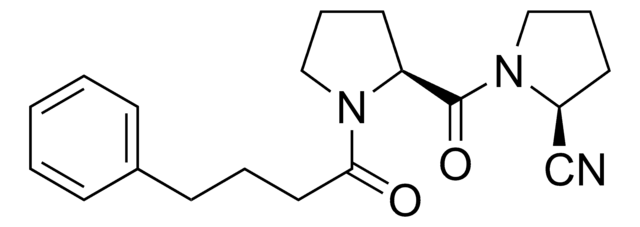SML0205
Z-Pro-prolinal
≥98% (HPLC)
Sinónimos:
Cbz-Pro-Prolinal, N-Benzyloxycarbonyl-L-prolyl-L-prolinal, Phenylmethyl (2S)-2-[(2S)-2-formylpyrrolidine-1-carbonyl]pyrrolidine-1-carboxylate, Z-Pro-Pro-CHO, Z-PP-CHO, Z-pro-pro-CHO, Z-prolyl-prolinal, ZPP
About This Item
Productos recomendados
assay
≥98% (HPLC)
form
powder
storage condition
desiccated
color
white to tan
solubility
DMSO: ≥10 mg/mL
storage temp.
−20°C
InChI
1S/C18H22N2O4/c21-12-15-8-4-10-19(15)17(22)16-9-5-11-20(16)18(23)24-13-14-6-2-1-3-7-14/h1-3,6-7,12,15-16H,4-5,8-11,13H2/t15-,16-/m0/s1
InChI key
ORZXYSPOAVJYRU-HOTGVXAUSA-N
Application
Biochem/physiol Actions
POP has been connected to memory and mood through regulation of the brain levels of its peptide substrates, which include AVP, substance P, neurotensin and TRH and is a potential target in cognitive function, memory, and neurodegenerative disorders such as amnesia, Alzheimer′s disease, and depression. POP has recently been reported to be involved in the release of the tetrapeptide acetyl-N-Ser-Asp-Lys-Pro (Ac-SDKP) from its precursor, 43-mer thymosin β4 (Tβ4). Ac-SDKP is involved in hemopoietic stem cell differentiation, is pro-angiogenic and antifibrogenic.
signalword
Warning
hcodes
Hazard Classifications
Acute Tox. 4 Oral - Eye Irrit. 2
Storage Class
11 - Combustible Solids
wgk_germany
WGK 3
flash_point_f
Not applicable
flash_point_c
Not applicable
Certificados de análisis (COA)
Busque Certificados de análisis (COA) introduciendo el número de lote del producto. Los números de lote se encuentran en la etiqueta del producto después de las palabras «Lot» o «Batch»
¿Ya tiene este producto?
Encuentre la documentación para los productos que ha comprado recientemente en la Biblioteca de documentos.
Los clientes también vieron
Artículos
We offers many products related to neuropeptidases for your research needs.
Nuestro equipo de científicos tiene experiencia en todas las áreas de investigación: Ciencias de la vida, Ciencia de los materiales, Síntesis química, Cromatografía, Analítica y muchas otras.
Póngase en contacto con el Servicio técnico











